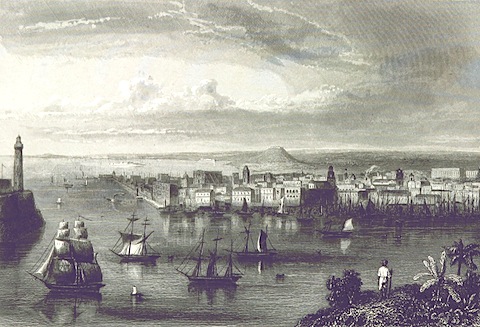Dear readers,
After more than a decade of active publication in print and online, The Caribbean Review of Books has been on indefinite hiatus since October 2016. It’s time to say publicly that we don’t plan to resume regular publication in the foreseeable future — although we leave open the possibility of a future return, and future evolution.
The economics of publishing a magazine like the CRB were always difficult, especially given our commitment to pay our writers, however modestly. Unable now to summon the resources to do so, our focus will be to complete the online archive of our back issues, dating to 2004, and ensure this remains freely accessible to all readers.
Many thanks to our numerous contributors over the years, and to our even more numerous readers, who gave the CRB purpose and motivation.
The editors
January 2020
•••
Under the weather
David Knight, Jr, reviews Climate and Catastrophe in Cuba and the Atlantic World in the Age of Revolution, by Sherry Johnson:
Image above: view of Havana from Géographie complète et universelle (1855), by Malthe Conrad Bruun. Public domain image posted at Flickr by the British Library
•
At the Kiosk of La Gitana
A poem by Loretta Collins Klobah:
Image above: the display window of a Puerto Rican botánica in New York City. From a photograph by Matt Green, posted at Flickr under a Creative Commons license
•
The self, centred
Nicole Smythe-Johnson reviews See Me Here: A Survey of Contemporary Self-Portraits from the Caribbean, edited by Melanie Archer and Mariel Brown:
Image above: The Secret (1992), by Irénée Shaw; oil on canvas, 32 x 32 inches. Courtesy Robert & Christopher Publishers
•
Portrait of a dictator
J. Michael Dash revisits Alejo Carpentier’s Reasons of State:
Image above: detail of La Marseillaise by sculptor François Rude, a relief on the Arc de Triomphe, Paris. From a photograph by Richard Mortel, posted at Flickr under a Creative Commons license
•
In transition
Isabel Guzzardo reviews Mala Mala, a documentary film directed by Antonio Santini and Dan Sickles:
Image above: Queen Bee Ho, one of the subjects of Mala Mala
•
From the CRB archive:
Grime is not always grime
Fiction by the late Anthony C. Winkler, excerpted from his novel Dog War, and first published in the August 2006 CRB:
Image above: posted at Flickr by Adam Bindslev under a Creative Commons license
•
Circa 1953
The CRB’s “Circa” column is an experiment in literary time travel: classic books of Caribbean literature reviewed by writers of the present, as though they were transported back to the time of original publication, and are unaware of the books’ subsequent reputation or their authors’ later careers. First in the series is Karen Lord on In the Castle of My Skin, George Lamming’s debut novel:
Image above: dust jacket of the first edition of In the Castle of My Skin, with an illustration by Denis Williams; from the H.D. Carberry Collection of Caribbean Studies, University of Illinois at Chicago Library, Special Collections and University Archives. Posted at Flickr under a Creative Commons license
•
Into the dark waters
Nishant Batsha reviews Coolie Woman: The Odyssey of Indenture, by Gaiutra Bahadur:
Image above: Detail of East Indian, Trinidad, B.W.I., a postcard from the Michael Goldberg Collection, courtesy the Alma Jordan Library, University of the West Indies, St Augustine
•••
The CRB’s online archive includes the full contents of every issue since 2009, and selections from older editions. In the coming months, we will add the full contents of every past issue to the new archive and subject index.












